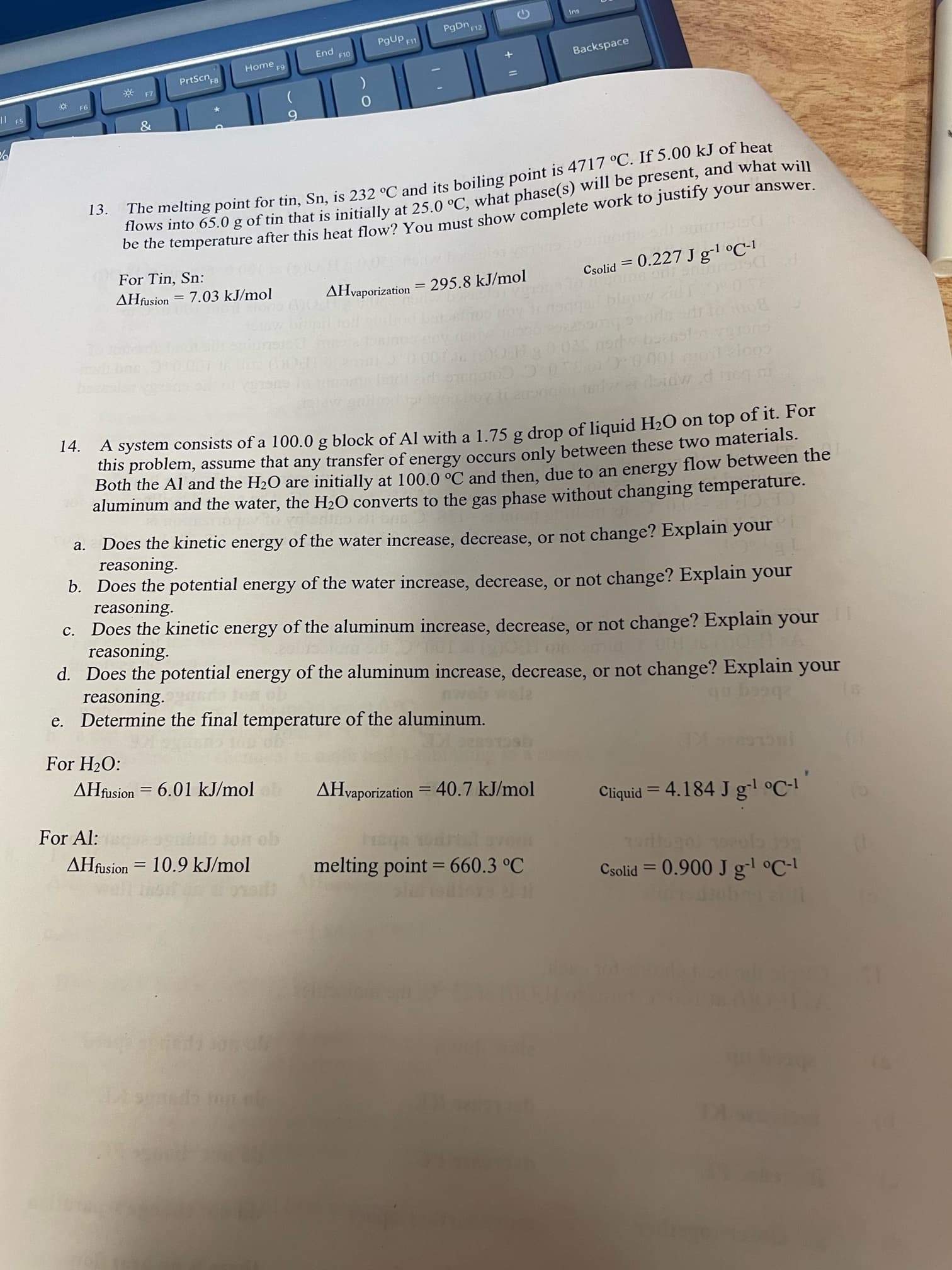End F10 Home F9 PrtScn8 F7 & Hoteling point for tin, Sn, is 232 °C and its boiling point is 4717 °C. If 5.00 kJ of heat Hows into 65.0 g of tin that is initially at 25 0 °C. what phase(s) will be present, and what will be the temperature after this heat flow? You must show complete work to justify your answer. 3. For Tin, Sn: AHfusion = 7.03 kJ/mol AHvaporization Csolid = 0.227 J gl °C-! 295.8 kJ/mol D0001 moloos O on top of it. For
End F10 Home F9 PrtScn8 F7 & Hoteling point for tin, Sn, is 232 °C and its boiling point is 4717 °C. If 5.00 kJ of heat Hows into 65.0 g of tin that is initially at 25 0 °C. what phase(s) will be present, and what will be the temperature after this heat flow? You must show complete work to justify your answer. 3. For Tin, Sn: AHfusion = 7.03 kJ/mol AHvaporization Csolid = 0.227 J gl °C-! 295.8 kJ/mol D0001 moloos O on top of it. For
Chemistry: Principles and Practice
3rd Edition
ISBN:9780534420123
Author:Daniel L. Reger, Scott R. Goode, David W. Ball, Edward Mercer
Publisher:Daniel L. Reger, Scott R. Goode, David W. Ball, Edward Mercer
Chapter17: Chemcial Thermodynamics
Section: Chapter Questions
Problem 17.103QE: A 220-ft3 sample of gas at standard temperature and pressure is compressed into a cylinder, where it...
Related questions
Question
Question 13

Transcribed Image Text:The point for tin, Sn, is °C and its is °C. If 5.00 kJ of heat
flows into 65.0 g of tin is at °C, will be will
Ins
P9DN F12
PgUP F1
End
Backspace
Home
PrtScn8
13.
oc the temperature after this heat flow? You must show complete work to justify your answer.
For Tin, Sn:
AHfusion = 7.03 kJ/mol
= P!Jos)
= 0.227 J g-l °C-I
AHvaporization = 295.8 kJ/mol
C Combnie
u borr p Ap
A system consists of a 100.0 g block of Al with a 1.75 g drop of liquid H2O on top of it. For
this problem, assume that any transfer of energy occurs only between these two materials.
Both the Al and the H2O are initially at 100.0 °C and then, due to an energy flow between the
aluminum and the water, the H2O converts to the gas phase without changing temperature.
14.
Does the kinetic energy of the water increase, decrease, or not change? Explain your
reasoning.
b. Does the potential energy of the water increase, decrease, or not change? Explain your
reasoning.
Does the kinetic energy of the aluminum increase, decrease, or not change? Explain your
reasoning.
d. Does the potential energy of the aluminum increase, decrease, or not change? Explain your
reasoning.
e. Determine the final temperature of the aluminum.
a.
C.
KE
Cliquid = 4.184 J gl °C-!
For H2O:
AHfusion = 6.01 kJ/mol
TECLC
AHvaporization = 40.7 kJ/mol
A.
For Al:
go
melting point = 660.3 °C
AHfusion = 10.9 kJ/mol
Csolid = 0.900 J g-l °C-l
EGO
he
Expert Solution
Step 1
Melting point of tin = 232°C
Step by step
Solved in 2 steps with 1 images

Knowledge Booster
Learn more about
Need a deep-dive on the concept behind this application? Look no further. Learn more about this topic, chemistry and related others by exploring similar questions and additional content below.Recommended textbooks for you

Chemistry: Principles and Practice
Chemistry
ISBN:
9780534420123
Author:
Daniel L. Reger, Scott R. Goode, David W. Ball, Edward Mercer
Publisher:
Cengage Learning

Principles of Modern Chemistry
Chemistry
ISBN:
9781305079113
Author:
David W. Oxtoby, H. Pat Gillis, Laurie J. Butler
Publisher:
Cengage Learning

Chemistry
Chemistry
ISBN:
9781305957404
Author:
Steven S. Zumdahl, Susan A. Zumdahl, Donald J. DeCoste
Publisher:
Cengage Learning

Chemistry: Principles and Practice
Chemistry
ISBN:
9780534420123
Author:
Daniel L. Reger, Scott R. Goode, David W. Ball, Edward Mercer
Publisher:
Cengage Learning

Principles of Modern Chemistry
Chemistry
ISBN:
9781305079113
Author:
David W. Oxtoby, H. Pat Gillis, Laurie J. Butler
Publisher:
Cengage Learning

Chemistry
Chemistry
ISBN:
9781305957404
Author:
Steven S. Zumdahl, Susan A. Zumdahl, Donald J. DeCoste
Publisher:
Cengage Learning

Chemistry: An Atoms First Approach
Chemistry
ISBN:
9781305079243
Author:
Steven S. Zumdahl, Susan A. Zumdahl
Publisher:
Cengage Learning


Physical Chemistry
Chemistry
ISBN:
9781133958437
Author:
Ball, David W. (david Warren), BAER, Tomas
Publisher:
Wadsworth Cengage Learning,